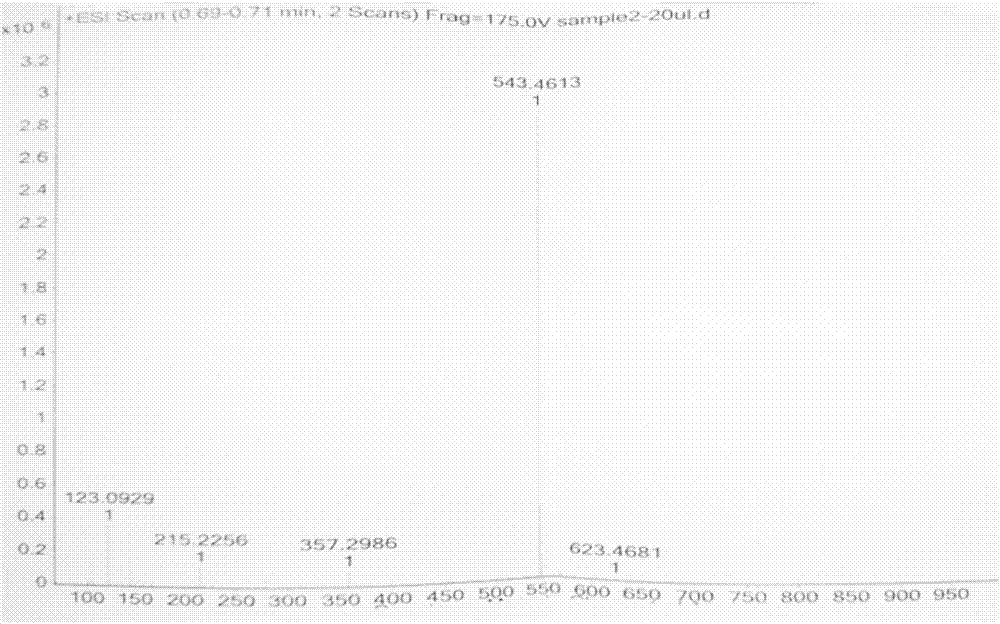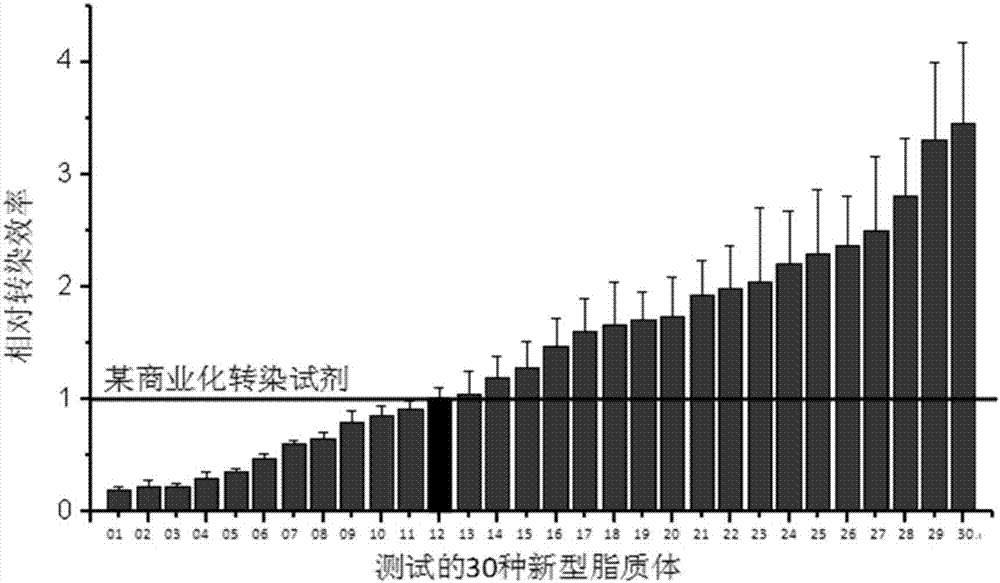A kind of cationic amino lipid and its synthesis method and application
An amino lipid and cationic technology, applied in the field of cell transfection, can solve the problems of limiting the application range of liposome transfection reagents, high production and R&D costs, and ineffective transfection, so as to reduce production costs and difficulty , the effect of increasing productivity
- Summary
- Abstract
- Description
- Claims
- Application Information
AI Technical Summary
Problems solved by technology
Method used
Image
Examples
Embodiment 1
[0038] Example 1: Synthesis of N-(2-(dimethylamino)ethyl)-4,5-bis(undecylthio)-4-pentenamide (LW-30)
[0039]
[0040] The synthesis of amino lipids is divided into two steps. The first step is the synthesis of 4,5-bis(undecylthio)-4-pentenoic acid. Dissolve 0.5 mmol 4-pentynoic acid, 0.75 mmol diundecyl disulfide and 5 mg 2,2-dimethoxy-2-phenylacetone phenyl ketone (DMPA) in 3 mL THF, and add 20 mL In a glass vial, the vial was irradiated with 365nm UV light for 1 h after deoxygenating with nitrogen gas for 5 min.
[0041] The second step is the amidation reaction of 4,5-bis(undecylthio)-4-pentenoic acid with N,N-dimethylethylenediamine to generate N-(2-(dimethylamino )ethyl)-4,5-bis(undecylthio)-4-pentenamide. Add 0.6mmol N,N'-diisopropylcarbodiimide (DIC) to the vial of the first step, stir well, then add 0.5mmol N,N-dimethylethylenediamine, stir for half an hour, then add 0.6 mmol dimethylaminopyridine, stirred overnight. Then the solution was poured into a 25 mL o...
Embodiment 2
[0042] Embodiment 2: the screening of the transfection activity of synthetic lipid
[0043] Cell line: HEK293
[0044] Transfection material: pBL-EGFP fluorescent plasmid
[0045] Cytotoxicity test method: MTT method
[0046] The first step; screening of transfection efficiency:
[0047] (1) Dissolving 29 new types of cationic lipid molecules synthesized in ethanol solution to prepare liposomes. The specific steps are to take 2 mg of each lipid molecule and place them in a round-bottomed flask, spin dry on a rotary evaporator overnight, add 1 mL of PBS solution to fully hydrate after the solvent is fully removed, and incubate on a rotary evaporator for 40 minutes. corresponding liposomes;
[0048] (2) Dissolve 50 nanograms of pBL-EGFP in 100 microliters of PBS, add 50 nanograms of liposomes, and incubate at room temperature for 30 minutes;
[0049] (3) HEK293 cells were digested with trypsin and diluted to 10 with serum-free DMEM medium 5 cell suspension per mL;
[0050] ...
Embodiment 3
[0057] Example 3: Rapid Transfection of Primary Mouse Embryonic Stem Cells
[0058] Amino lipids obtained by hydration Prepare 2mg / mL liposome, which is the mother solution of transfection reagent for cell transfection.
[0059] Reagent: Tube A is the mother solution of the transfection reagent of the present invention; Tube B is the 1×PBS dilution
[0060] Cell line: primary mouse embryonic stem cells
[0061] Transfection material: pBL-EGFP fluorescent plasmid
[0062] Quick transfection step
[0063] (1) Shake tube A slightly before use to mix the solution evenly, take 10 microliters of transfection reagent mother solution and add 390 microliters of 1×PBS dilution to make transfection working solution;
[0064] (2) Dissolve 500 nanograms of pBL-EGFP in 400 microliters of 1× diluent to make a DNA suspension;
[0065] (3) Mix the transfection working solution and DNA suspension at a volume ratio of 1:1 to make a transfection solution and incubate at room temperature for...
PUM
 Login to View More
Login to View More Abstract
Description
Claims
Application Information
 Login to View More
Login to View More - R&D
- Intellectual Property
- Life Sciences
- Materials
- Tech Scout
- Unparalleled Data Quality
- Higher Quality Content
- 60% Fewer Hallucinations
Browse by: Latest US Patents, China's latest patents, Technical Efficacy Thesaurus, Application Domain, Technology Topic, Popular Technical Reports.
© 2025 PatSnap. All rights reserved.Legal|Privacy policy|Modern Slavery Act Transparency Statement|Sitemap|About US| Contact US: help@patsnap.com



